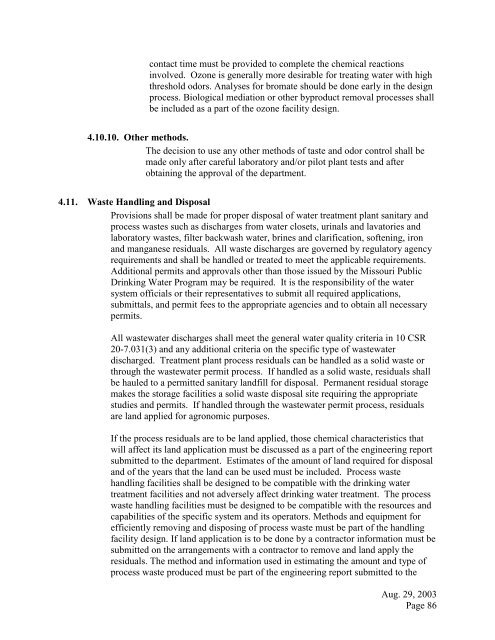Design Guide for Community Water Systems - The Water, Sanitation ...
Design Guide for Community Water Systems - The Water, Sanitation ...
Design Guide for Community Water Systems - The Water, Sanitation ...
Create successful ePaper yourself
Turn your PDF publications into a flip-book with our unique Google optimized e-Paper software.
contact time must be provided to complete the chemical reactionsinvolved. Ozone is generally more desirable <strong>for</strong> treating water with highthreshold odors. Analyses <strong>for</strong> bromate should be done early in the designprocess. Biological mediation or other byproduct removal processes shallbe included as a part of the ozone facility design.4.10.10. Other methods.<strong>The</strong> decision to use any other methods of taste and odor control shall bemade only after careful laboratory and/or pilot plant tests and afterobtaining the approval of the department.4.11. Waste Handling and DisposalProvisions shall be made <strong>for</strong> proper disposal of water treatment plant sanitary andprocess wastes such as discharges from water closets, urinals and lavatories andlaboratory wastes, filter backwash water, brines and clarification, softening, ironand manganese residuals. All waste discharges are governed by regulatory agencyrequirements and shall be handled or treated to meet the applicable requirements.Additional permits and approvals other than those issued by the Missouri PublicDrinking <strong>Water</strong> Program may be required. It is the responsibility of the watersystem officials or their representatives to submit all required applications,submittals, and permit fees to the appropriate agencies and to obtain all necessarypermits.All wastewater discharges shall meet the general water quality criteria in 10 CSR20-7.031(3) and any additional criteria on the specific type of wastewaterdischarged. Treatment plant process residuals can be handled as a solid waste orthrough the wastewater permit process. If handled as a solid waste, residuals shallbe hauled to a permitted sanitary landfill <strong>for</strong> disposal. Permanent residual storagemakes the storage facilities a solid waste disposal site requiring the appropriatestudies and permits. If handled through the wastewater permit process, residualsare land applied <strong>for</strong> agronomic purposes.If the process residuals are to be land applied, those chemical characteristics thatwill affect its land application must be discussed as a part of the engineering reportsubmitted to the department. Estimates of the amount of land required <strong>for</strong> disposaland of the years that the land can be used must be included. Process wastehandling facilities shall be designed to be compatible with the drinking watertreatment facilities and not adversely affect drinking water treatment. <strong>The</strong> processwaste handling facilities must be designed to be compatible with the resources andcapabilities of the specific system and its operators. Methods and equipment <strong>for</strong>efficiently removing and disposing of process waste must be part of the handlingfacility design. If land application is to be done by a contractor in<strong>for</strong>mation must besubmitted on the arrangements with a contractor to remove and land apply theresiduals. <strong>The</strong> method and in<strong>for</strong>mation used in estimating the amount and type ofprocess waste produced must be part of the engineering report submitted to theAug. 29, 2003Page 86
















